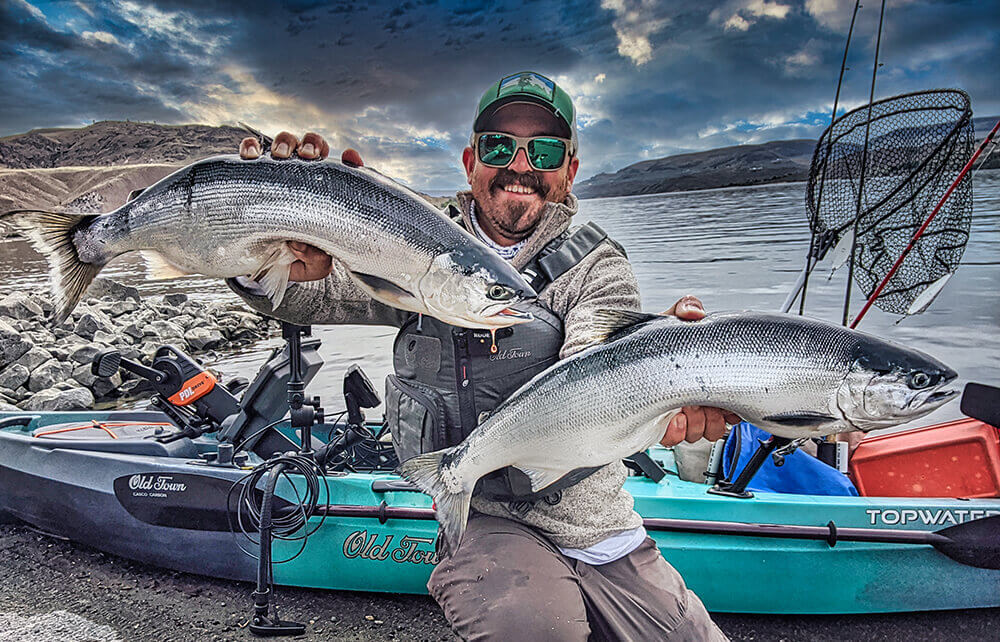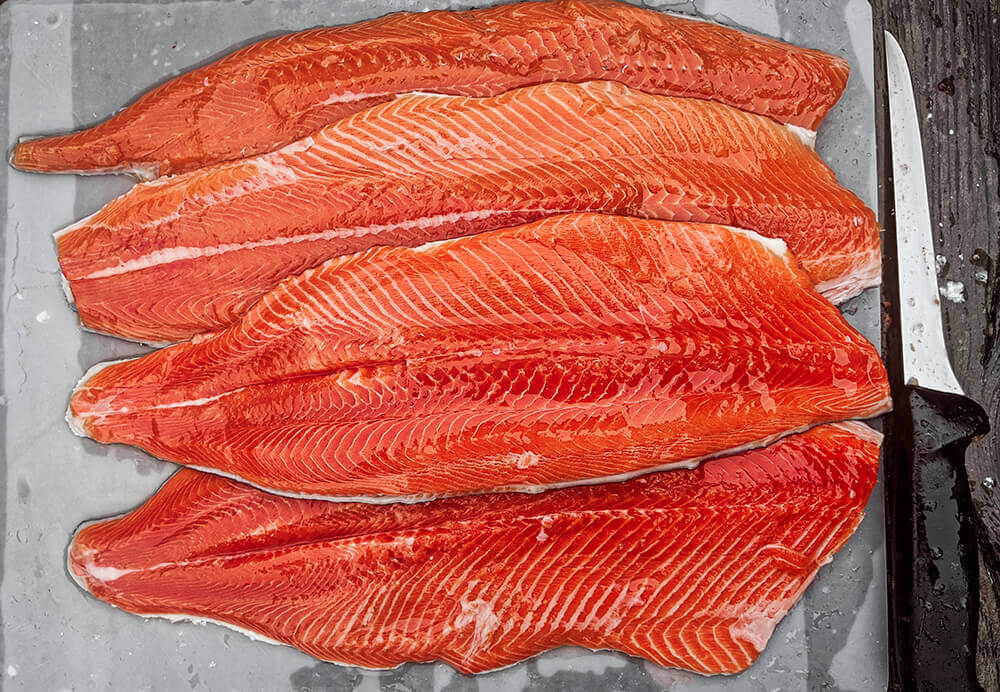Top Ten Kayak Kokanee Fisheries
By: Tyler Hicks
Kokanee, landlocked Sockeye Salmon, are fast emerging as one of the most popular kayak fisheries in the western United States where they are found in numerous mountain lakes and cold water reservoirs. While they typically grow to 10-15” and seldom grow larger than one to two pounds, there are a few bodies of water that consistently produce world class Kokanee in the three to five plus pound range. Like their ocean run cousins, these fish will go through population cycles with some years producing many small fish and in other years fish are scarce, but large. Chasing trophy sized fish is like chasing a mirage, they are there one year and then gone the next. However, there are a few exceptions to this rule and they are noted below. No matter their size, these fish taste delicious on the grill or smoked. Here are my top ten kayak Kokanee fisheries chosen for the quality and quantity of the fish, the beauty of the scenery, and the ease of access to the kayak angler.

- Flaming Gorge Reservoir, Utah and Wyoming: The Holy Land...errr I mean Holy Water of Kokanee anglers. No other body of water is renowned for its big Kokanee than this giant desert reservoir straddling the border of Utah and Wyoming. Three pound or larger Kokanee are more the norm here than any other reservoir in the world. The best time to fish it is in June when fish are actively feeding in the upper 30’ of the water column. There are several good fishing locations near marinas and launch points including Linwood Bay, Anvil Draw, and Buckboard but they can be found almost anywhere.
- Lake Berryessa, California: Somehow this lake manages to support a world class fishery for just about every kind of fish and Kokanee are no exception. Recently coming out of a cycle where the lake was producing 20-22” fish that rivaled those at Flaming Gorge the lake, even during its “off years”, produces quality 15-17+” fish up to two pounds. It’s anybody’s guess when the big ones will return but with trophy Largemouth Bass (we are talking 10+ lb bass), Crappie, Rainbow Trout and more all piled into this lake there is plenty to keep your busy. As for Kokanee April through early June is best to target these fish before they go deep. Your best bet is to focus on areas near the dam in the Markley Cove to Portuguese Canyon area or Wragg Canyon Inlet easily reached by launching at Pleasure Cove.
- Wallowa Lake, Oregon: The world record Kokanee was caught here and weighed in at a staggering 9.67 pounds. The days of the giants are gone but the lake still produces a diversity of age classes and sizes of fish. Kayak anglers who put in their time will be rewarded with fish in the 18-20” class weighing two to four pounds but expect to weed through 10-15” fish to find the big ones. If the fish aren’t biting you’ll have plenty of natural beauty to absorb as the snow-capped Wallowa Mountains tower overhead. This lake is best fished from late May through early July when the fish are feeding in the top 20’ of the water column. The north end of the lake offers your best opportunity and kayak anglers should focus on following the shoreline zig-zagging across the 20-50’ depth range. There is a convenient launch on the north end and you can start fishing immediately upon launch. It can snow here in June, as I discovered on a recent trip so be prepared. The nearby town of Joseph, Oregon offers a great variety of tasty foods, breweries, and plenty of distractions for your non-fishing friends and family.
- Lake Roosevelt, Washington: Slicing through northeast Washington Lake Roosevelt is a massive body of water held back by 12 million cubic yards of concrete encased at the Grand Coulee dam. The lake supports a wild population of Kokanee that on a cyclical basis grow to in excess of 5 lbs. Limits are restrictive with only two wild fish allowed per angler. While the reservoir is massive most of the Kokanee concentrate in the lower reaches of the reservoir from Keller’s Ferry downstream to the dam. There are several launches all within close striking distance of key fishing grounds at the mouth of the San Poil Arm, Spring Canyon, and the dam. Fishing is best from March through May when fish will be feeding near the surface. As an added benefit you will no doubt intercept the lakes large 2-4 lb Rainbow Trout which are consistently available to anglers every year.
- Blue Mesa Reservoir, Colorado: Winter comes late to the Gunnison Basin of Colorado where the state’s best Kokanee fishery resides at Blue Mesa Reservoir. Depending on the winter, snow packs, and melt the lake can either be ice capped or dirty well into May. This reservoir produced a 7 pound 5 ounce Kokanee but more typically produces Kokanee in the one to three pound range. Fishing is best from June through early August but may kick off earlier if snowpacks are light. There are an abundance of ramps and access points to launch a kayak that are close to proven Kokanee grounds which include Soap Creek, Cebolla Basin, the Lake Fork, and just below the tiny town of Sapinero. If you get tired of trolling for Kokanee try jigging for the lakes massive Mackinaw which grow to well over 20 lbs.
- Kalamalka Lake, British Columbia, Canada: For a time this lake seem destined to produce a world record fish as several Kokanee in the seven to eight pound range were caught but alas it has not. Still this picturesque aqua-marine lake nestled in the wine country of Canada produces trophy class fish in the 20”+ range year in and year out. Spring comes late to the Okanogan of British Columbia and fishing is best from late May through June when fish will be feeding in the upper 40’ of the lake. Things heat up rapidly in July and the fish dive deep often in excess of 100’. Kayak anglers should focus their efforts on the north end of the lake and have options to launch at Kekuli Bay or beach launch at Kal Beach.
- Merwin Reservoir, Washington: Tucked in the rolling forested foothills at the base of Mount Saint Helens this Evergreen state gem is where I cut my teeth on kayak Kokanee. Fish are consistently 13-16” with a generous 10 fish limit. Natural production and a Kokanee hatchery help to maintain the quality of this fishery. Fishing kicks off early here with late March thru May offering your best bet at targeting these fish which will be feeding in the upper 30’ of the water column. You can launch at Speelyai Bay and start trolling as soon as you leave the cove. Troll downlake until you find fish and watch for westerly winds as they can get this lake rolling. After fishing stop by the hatchery and check out the baby Kokanee and some giant brood stock Rainbow Trout.
- West Hill Pond, Connecticut: Kokanee in Connecticut? Yes and even more amazing is a state record tying 2 lb 14 oz Kokanee was caught here in 2018. The state of Connecticut nets brood stock each fall and raises the Kokanee fry at Burlington Hatchery where they release almost 200,000 fry annually in several regional lakes. At only 260 acres the lake is relatively easy to cover but you’ll need Trout and Salmon stamp to harvest any fish. You won’t find better Kokanee fish within 1600 miles!
- Lake Coeur d’Alene, Idaho: This north Idaho gem is loaded with Kokanee. The lake has a generous 15 fish limit. The average size of the Kokanee in this lake has not been much more than 10-12” for the past decade. However, in the past few years the fish have averaged an impressive 13-15” and they just seem to keep getting bigger. As a bonus, large 5 to 15 lb landlocked Chinook Salmon can be caught here often feeding on the Kokanee so look for large marks on your fishfinder below the schools of little salmon. Spring and early summer are best with the areas around Arrow Point, Carlin Bays, and Mica Bays all consistently holding fish. The lake also offers world class Smallmouth Bass and Northern Pike fishing.
- Deep Lake, Washington: One of the smallest lakes on the list this narrow deep lake might be one of the most picturesque lowland Kokanee lakes in the western United States. Fish here never seem to grow beyond 12-13” but they are abundant and you almost certainly will be distracted by the mesmerizing basalt columns, formed as massive lava flows cooled slowly, that tower over you in this canyon lake. The lake itself was carved by massive ice age floods that ripped across Washington slicing huge canyons called coulees. A small boat ramp is available on the west end of the lake where a big grove of large silver poplars provide a cool respite from the summer heat. Fishing here is good nearly all season but expect fish to be as deep as 40’ in the summer.
This is only a sampling of hundreds if not thousands of lakes that hold Kokanee. Be sure and check with your local fish and game department for additional Kokanee fishing opportunities and regulations in your state or province.
